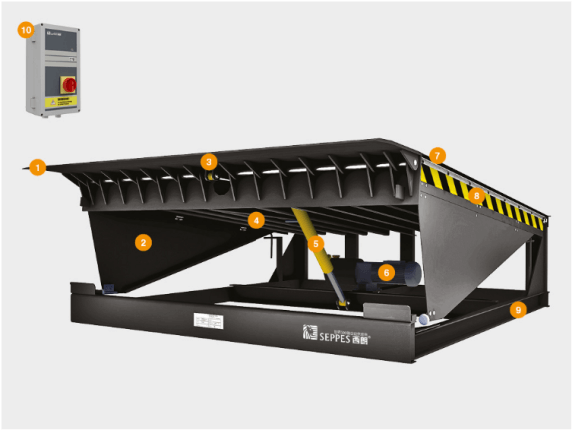In the field of modern logistics, hydraulic dock leveler play an indispensable role. And their carrying capacity is directly related to the safe transportation and loading and unloading efficiency of goods. However, have you ever wondered what factors are closely related to the load capacity of a hydraulic loading and unloading platform? This blog will deeply explore the relationship between the load capacity of hydraulic loading and unloading platforms and key factors. Let’s solve this mystery together!Get to know the dock leveler
Get to know the dock leveler

1. Lip plate 2. Side curtain safety baffle 3. Lip cylinder 4. Table support steel 5. Lifting cylinder 6. Hydraulic pump 7. Sealing rubber strip 8. Yellow and black strips 9. Base 10. Motor
Basic principles of dock leveler
The dock leveler is a crucial component of the loading system, operating seamlessly via a control system. It consists of an electric-hydraulic power unit, adjustment plate, and tongue plate, designed to accommodate height disparities between various transport vehicle floors and the platform. This setup enhances loading and unloading efficiency by forming a smooth transition between the vehicle and the platform. It boasts a dynamic rated load of 6.3 tons and a static rated load of 13.6 tons.
To ensure safety, automatic retractable body guards are installed on both sides. Additionally, it features a reliable hydraulic control speed safety valve and an anti-fall valve safety protection device. The innovative double 5-arch bridge type reinforced tongue design, spanning 400 mm, facilitates smoother transitions and effectively prevents damage from forklifts and loading platforms.
For specialized environments, telescopic loading and unloading platforms can be tailored. These platforms support a dynamic load of 6,000 KG, a static load of 8,000 KG, and offer a telescopic length of 1,000 mm.
Relationship between design specifications and load capacity
The design specifications of a hydraulic dock leveler are one of the important factors that determine its load capacity. The size, material selection, structural design and other aspects of the platform directly affect its load-bearing capacity. For example, larger platforms usually have higher load-carrying capacity, and the use of high-strength materials and properly designed structures can also increase the platform’s load-bearing capacity. SEPPES Common sizes on the market include W 2 m H 2.5 m D 0.6 m and W 2 m H 2.0 m D 0.6 m.
Hydraulic system performance impact
The hydraulic system is the core of the hydraulic dock leveler and its performance directly affects the load-carrying capacity of the platform. By inverting the hydraulic oil, you can effectively prevent dust accumulation, prevent oil leakage from the oil cylinder, and prevent safety lock failure. The power, pressure, flow and other parameters of the hydraulic system will affect the lifting speed and carrying capacity of the platform. Therefore, improving the performance of the hydraulic system can effectively increase the load capacity of the platform.

Material and structural strength
Material selection and structural strength are another important factor affecting the load capacity of a hydraulic dock leveler. The use of high-strength materials and properly designed structures can improve the platform’s load-bearing capacity. During the design and manufacturing process, it’s essential to consider the durability of materials and the stability of the structure to ensure the platform possesses sufficient load-bearing capacity. Generally, manufacturers commonly use steel structures in dock levelers.

Environment and working conditions
The use environment and working conditions of the hydraulic dock leveler will also impose requirements on its load capacity. In different working environments, the platform may need to have different carrying capacities to adapt to different challenges. Therefore, when selecting and using a hydraulic dock leveler, the characteristics and requirements of the working environment must be considered to ensure that the platform can meet actual needs. A variety of factors affect the load-carrying capacity of a loading and unloading platform, including design specifications, hydraulic system performance, material and structural strength, as well as the usage environment and working conditions.Understanding the interaction between these key factors is critical to optimizing the design and application of dock leveler.

Future development trends of dock leveler
As time goes.The technological innovation and market trends of future dock leveler will be affected by automation and intelligence trends, green environmental protection requirements, logistics industry development needs, safety and reliability requirements, diversified needs and customization trends, as well as international trade and globalization. the combined influence of factors.




